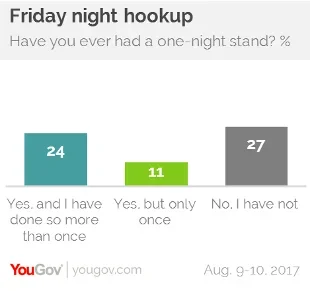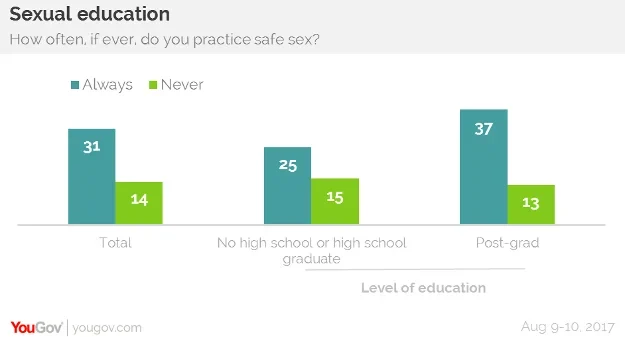And 14% of Americans say they never practice safe sex
In the age of Tinder hookups, it likely comes as no surprise that 35% of Americans have had a one-night stand. However, are these brusque sexual encounters safe? Further data from YouGov reveals that one in four men have had unprotected sex with their one-night stands, as well as 14% of women.
However, it isn’t just during trysts that Americans aren’t using protection: 14% of respondents say they never practice safe sex.

One of the many common reasons given for not regularly using condoms is that they dull sensation and sexual pleasure. While perspectives on this assertion range dramatically, 16% of US adults have forgone a condom because their partner didn’t like how it felt.
Numerous reports show that the number of individuals infected with STDs is on the rise, especially for young adults. One of the likely sources of this influx is unawareness that many infections can be spread orally, including some of the most prevalent types of STDs such as chlamydia and gonorrhea. 34% of Americans never use protection during oral sex.
On the bright side, 31% of US adults always practice safe sex. However, these numbers fluctuate in regards to level of education and age. 25% of those with only a high school education always practice safe sex, compared to 37% of individuals with a post-grad degree.

Similarly, 26% of Americans in a lower income bracket—people whose income in under $40,000— always practice safe sex, while 40% of those who make over $80,000 do.
The correlation between safe sex and income may in part be due to how difficult it is to access affordable birth control for many women – especially for undocumented individuals, or those who don’t have suitable insurance coverage. In fact, 74% of US women do not currently use any form of birth control (excluding condoms, but including the pill, the patch, an IUD, etc)—this includes 52% of millennials.
Aside from traditional forms of birth control, there has long been debate over the legitimacy of the “pull out method” as a viable option for reducing the risk of pregnancy. Regardless of its effectiveness, a third of US adults, 33%, have used this technique.






